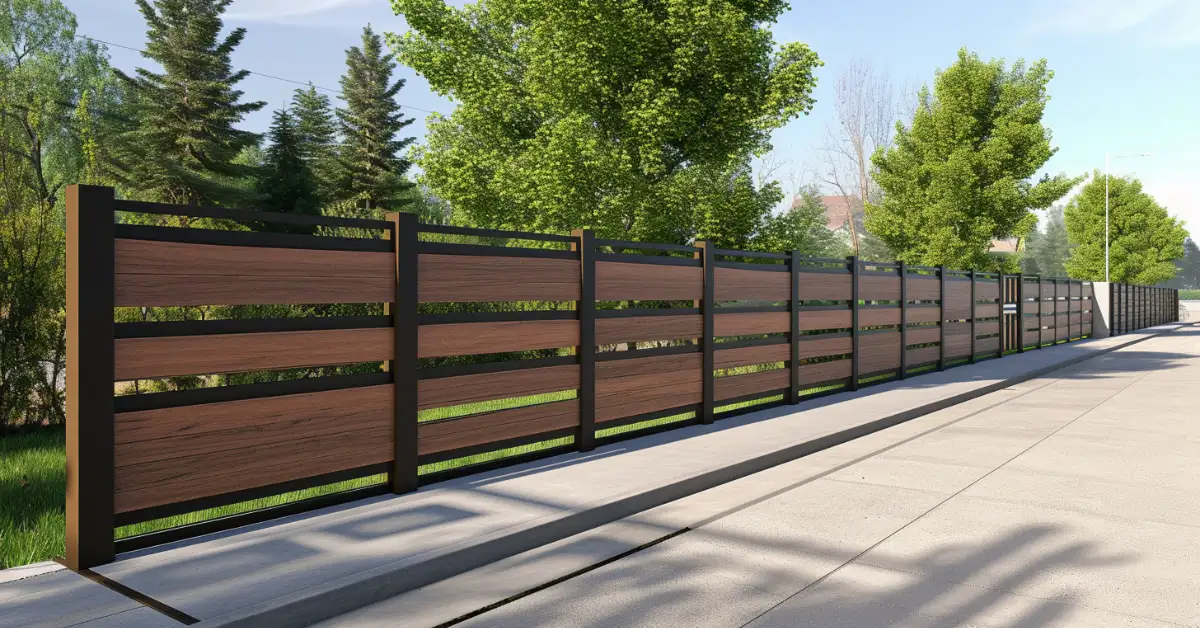Modern fences do more than define property lines; they’re a fusion of privacy and style, enhancing your home’s curb appeal. Discover how the right modern fence transforms your space, merging functionality with cutting-edge design to create a personal oasis that stands out. Explore the latest in fencing innovation and find the perfect blend of seclusion and aesthetic for your home.
What Defines a Modern Fence?
When I think about a modern fence, the first thing that comes to my mind is sleek designs that complement a home’s architecture while offering privacy and security.
| Element | Description |
|---|---|
| Materials | Common materials used for modern fences include wood, metal, vinyl, and composites. Materials are often chosen for durability and ease of maintenance. |
| Design Ideas | Popular designs incorporate horizontal slats, mixed materials (such as wood with metal accents), and clean lines. |
| Privacy | Fences with minimal gaps between slats or panels offer more privacy, while still providing an aesthetically pleasing look. |
| Security | Heights and sturdiness play a key role in security. Options may include reinforced gates or locking systems. |
| Curb Appeal | The look of a modern fence often aligns with the architectural style of the house, enhancing the overall appearance and potentially increasing property value. |
| Heights | Height regulations may be determined by local zoning laws, but modern fences often range from waist-high for decorative purposes to about 6 feet for privacy. |
| Styles | Styles vary from minimalist and industrial to more intricate patterns that still maintain simplicity. |
| Gaps | Intentional gaps are sometimes used in modern fences for a patterned effect, balancing privacy with aesthetics. |
| Fence Designs | Designs can range from uniform panels to a more varied, rhythmic pattern that adds visual interest to the property’s perimeter. |
| Planning | It’s crucial to plan for the integration of the fence with the existing landscape and architectural style, ensuring an uncluttered and harmonious look. |
The styles and materials I’ve mentioned not only serve practical functions but also play an essential role in the modern aesthetic. These fences are designed to be both functional and beautiful, adhering to the principle that less is more.
Types of Materials and Their Advantages
As I explore the realm of modern fence materials, I’m struck by the array of options that balance aesthetics with functionality. Whether you’re looking to enhance privacy, security, or simply add a decorative touch to your property, you’ll find a fit for your needs.

Wood and Composite Fencing
Wood: I find that classic materials like cedar have timeless appeal. Cedar is not only visually warm but also contains natural oils that make it resistant to decay, insects, and harsh weather conditions. Composite: On the other hand, composite fencing is a mixture of wood fibers and plastic. Its main advantage is low maintenance, resisting the pitfalls of traditional wood such as warping or rotting, making it a practical choice for a modern fence.
Metal Fencing Options
- Aluminum: Lightweight and corrosion-resistant, aluminum fencing is a versatile option I recommend for decorative and less-intensive security needs.
- Steel: When safety is your priority, few materials match the resilience of steel, which provides considerable strength for a secure boundary.
- Wrought Iron: I admire wrought iron for its intricate designs and robust structure, perfect for those who want a stately appearance without compromising security.
Vinyl and Other Synthetic Options
Synthetics such as vinyl offer a virtually maintenance-free experience. Vinyl, specifically, stands up to weathering, doesn’t require painting or staining, and can effectively mimic the look of other materials. This makes it a smart pick for a modern fence that retains its appearance with minimal effort.

Natural and Eco-Friendly Variations
Bamboo: Bamboo fencing is an option I find both visually pleasing and environmentally sustainable. It’s a strong, naturally regenerative resource that adds a unique aesthetic. Recycled Materials: For those of us who are ecologically conscious, using recycled materials for fencing can significantly reduce environmental impact while still providing durability and style.
Each of these materials brings its distinct advantages to the table, catering to a variety of preferences and needs in the context of designing a modern fence. Whether prioritizing durability, maintenance, or eco-friendliness, you’ll surely find a fencing material that aligns with your specific demands.
Fence Styles and Patterns
When I consider updating my outdoor space, choosing the right modern fence becomes an essential part of the landscape design. It’s amazing how the proper style can transform the look and feel of my property.
The Charm of Picket Fences
Picket fences have always exuded a classic appeal, and in the realm of modern fence design, they get a fresh twist with various materials and finishes. For my home, vinyl picket fences offer durability and require minimal maintenance, while a painted wooden picket can add a quaint, traditional touch.

Elegance of Lattice and Horizontal Slats
The traditional lattice has been redefined with a modern fence flair. I adore the sophisticated patterns that are now available, bringing both style and privacy to my yard. Moreover, horizontal fences are all the rage, providing a sleek and contemporary look with the bonus of privacy. Whether it’s cedar wood or powdered coated aluminum, the aesthetic these slats present aligns perfectly with a modern mindset. You can gather some great ideas for modern combinations of lattice and wood.
Innovative Uses of Concrete and Stone
Who knew that concrete and stone could be so versatile? I’m thoroughly impressed by the innovation in modern fence designs that incorporate these sturdy materials. A concrete wall can be both a statement piece and a fortress for privacy. In contrast, stone offers a textured, natural vibe that’s unmatched. For instance, integrating stone blocks with iron or wood can create a sturdy and visually appealing barrier for my property.
Integrating Fences with Garden and Landscape
I love how a modern fence isn’t just a boundary but a key element of landscape design. It pairs with the greenery to create a seamless flow between man-made and natural elements.

Incorporating Greenery and Climbing Plants
Greenery: To blend fences naturally with your garden, consider using lush hedges or dense shrubbery. Such living walls not only enhance privacy but also contribute to the garden’s ecosystem. In cases where space is at a premium, vertical gardens are an excellent solution, transforming fences into verdant focal points.
Climbing Plants: Climbing plants like ivy, clematis, or jasmine can turn a static fence into a dynamic feature. They add texture and color, with the added benefit of attracting wildlife. Use trellises or wires to support climbers, ensuring they interweave with the fence as they grow.
Popular Climbers for Modern Fences:
- Ivy (Hedera) – Hardy and evergreen.
- Clematis – Known for their vibrant flowers.
- Jasmine (Jasminum) – Fragrant blooms enhance sensory appeal.
Fences as a Backdrop for Garden Beds
A modern fence can act as the perfect backdrop to highlight garden beds. By choosing the right color and material for your fence, you complement the hues of the flowers and foliage. For a minimalist design, neutral tones work well, while bolder colors can make a statement and accentuate the plants.
Fence Colors as Backdrops:
- Neutral (Grey, Beige) – Subtly showcases plant varieties.
- Bold (Blue, Green) – Draws the eye and creates contrast.
Maximizing the interplay between fences and greenery not only beautifies the landscape but encourages biodiversity within your outdoor space. By selecting the right plants and materials, you can ensure that your garden and fencing enhance each other perfectly.

Ensuring Fence Durability and Maintenance
When I’m considering a modern fence for a home, two of the most crucial aspects I focus on are durability and maintenance. Getting these right means we can enjoy our fence without constant repairs and replacements, saving time and money in the long run.
Choosing the Right Materials for Your Climate
For a fence to stand the test of time, particularly in varying climates, choosing suitable materials is essential.
- Vinyl: It’s known for its resilience and can withstand harsh weather conditions without rotting, warping, or fading. Vinyl fences last between 20-30 years and are a practical choice with minimal maintenance needs.
- Wood: Different types of wood, like treated wood, redwood, and ipe, offer varying levels of insect resistance and durability. Redwood especially is known for its resistance to decay and insects, making it a stunning and sturdy option for those in stock. Properly maintained, these fences can serve well for 10-20 years.
- Metal: If I live in an area with high humidity or frequent rain, ornamental or chain-link metal fences are durable but require attention to prevent rust.
Maintenance Tips for Longevity
Regular maintenance can drastically improve the lifespan of your modern fence, keeping it as a reliable part of your property’s security and aesthetics.
- Inspect Regularly: I make it a point to check my fence several times a year for signs of damage or wear, addressing issues promptly to avoid more significant problems.
- Cleaning: Regular cleaning helps prevent the build-up of dirt and grime which can lead to rot in wood and rust in metal fences. Using the right cleaning tools and mild detergents keeps the fence in top shape.
- Immediate Repairs: If I notice any cracks or breaks, especially in vinyl fencing, I tackle repairs immediately using vinyl repair kits or replacing damaged parts to prevent further damage.
By choosing the right materials for my climate and adhering to these maintenance tips, I ensure my modern fence remains durable and beautiful for years to come.

My Practical Tips and Ideas for DIY Fence Projects
As a modern fence enthusiast, I absolutely adore the sleek look that a DIY modern fence can add to a home’s outdoor space. Tackling such a project can be rewarding, but it’s important to consider the design and materials to ensure your fence is not just beautiful but also functional.
| Material | Pros | Cons | Best for |
|---|---|---|---|
| Wood Slats | Warm, natural look; customizable | Maintenance required; may warp | Privacy fences |
| Pallet | Recyclable; inexpensive | Limited durability; may look too rustic | Rustic or temporary solutions |
| Vinyl Fencing | Low maintenance; long-lasting | Can have a plastic look; costlier | Sleek, clean lines |
| Prefab Panels | Easy installation; consistent quality | Less customizable; more expensive | Quick setups |
No matter what you decide, make sure you plan thoroughly before starting your project. Happy building!
FAQ – Modern Fence
How do I make my fence look modern?
For a modern fence, consider using black horizontal slats, sleek metal posts, or combining materials like brick and metal for a contemporary look.
What is the most inexpensive fence to put up?
The most inexpensive fence options typically include materials like treated pine, chain link, and chicken wire, which are known for their low cost and ease of installation.
What is cheaper than fencing?
Natural reed or bamboo fencing is a budget-friendly alternative to traditional fencing materials, offering a tropical aesthetic at a lower cost. Chicken wire is also a dirt-cheap way to enclose an area.
What is the most popular privacy fence?
The most popular privacy fence is often a wood privacy fence, due to its traditional look, versatility, and the privacy it offers. Vinyl fences are also popular for their durability and low maintenance.
If you enjoyed our blog post on “Modern Fence,” we’d love to hear your thoughts! Please share your experiences with us in the comment section below.
If you want to keep reading more from us, have a look at these articles.


